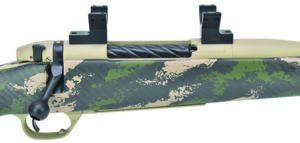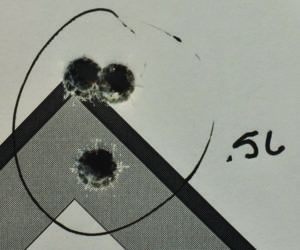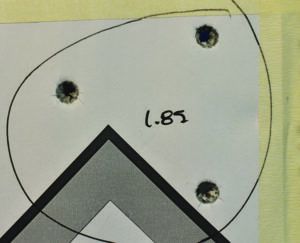GUN TESTS GRADE: B+
$2249
Weatherby has long understood that speed kills. They wanted their own fast 6.5-caliber hunting round and decided to take a different path to get there. Weatherby made their mark producing rifles that shot screaming fast, proprietary cartridges. Starting with the development of their 300 Weatherby Magnum in 1944, Weatherby has used fat, belted cases, their trademarked double-radius shoulder and lots of free bore to create their own family of high-speed hunting rounds. They dipped their corporate toes in the modern 6.5 market in 2016 with the introduction of the 6.5-300 Weatherby round. To make it, they necked the 300 Weatherby Magnum down to 6.5 in a case that could send a 140-grain bullet downrange at nearly 3400 feet per second.
| Action Type | Bolt, Mark V 6-lug |
| Overall Length | 44.5 in. |
| Barrel Length/Twist | 24 in., 1:8 |
| Overall Height w/o Scope Mount | 6 in. |
| Weight Unloaded | 5.6 lbs. |
| Weight Loaded | 6.0 lbs. |
| Sight Radius | NA |
| Action Finish | McMillan Tan Cerakote Steel |
| Barrel Finish | McMillan Tan Cerakote Steel |
| Magazine Capacity | 4 |
| Magazine Type | Internal, hinged floorplate |
| Stock Material | AG Composite carbon fiber |
| Stock Drop at Comb | 0.6 in. |
| Stock Drop at Heel | 0.3 in. |
| Stock Bedding | Spot bedding with pillars |
| Stock Buttplate | 3D Hex Recoil Reducer |
| Stock Length of Pull | 13.75 in. |
| Receiver Scope-Base Pattern | Weatherby Mark V |
| Trigger Pull Weight | 2.3 lbs. |
| Safety | 2-position rotating switch on bolt shroud |
| Warranty | None written |
| Telephone | (307) 675-7840 |
| Website | Weatherby.com |
| Made In | USA, Wyoming |
They recently decided to expand their offerings in the 0.264-inch genre but did so in a way surprisingly different from their standard designs. They started with a 284 Winchester as the parent case. The 284 Win. has the same rim diameter (nominally .473 inch) as the 30-06 Springfield, 308 Winchester, 6.5 Creedmoor, etc., but the rim is rebated so that it is narrower than the case body proper. This allows the manufacturers to use one of the most common bolt-head dimensions extant with a wider case body, offering more room for powder. The 6.5 Weatherby RPM (Rebated Precision Magnum) uses the same rebated rim and 35 degree shoulder as the parent round, while they lengthened the case a bit, allowing for, you guessed it, more powder.

Both the 6.5 Weatherby RPM and the 6.5 PRC are essentially trying to do the same thing — make a 6.5mm-diameter bullet go faster than the wildly successful 6.5 Creedmoor while ascribing to the same accuracy standard. The 6.5 PRC uses a CM-style short, fat case, allowing it to be housed in a short-action rifle. All things being equal, shorter, stiffer actions can mean more potential for accuracy. Downside: Those same short, fat cases take up more room in the magazine, limiting the ammo that can be carried onboard. The 6.5 WBY RPM uses a somewhat narrower case that is longer, therefore requiring the use of a standard length, but more slender, action. It was also said to be faster than the 6.5 PRC. “Potential” always makes for an interesting conversation, but only the shooting will tell.
If ounces turn into pounds and pounds turn into pain, the Weatherby Mark V Backcountry should be about as painless as is possible. Everything about this rifle is designed to make it easier to take long walks up and down steep hills in search of furry critters. Our sample weighs in at a feathery 5.6 pounds. The 24-inch barrel has a 1-in-8-inch twist and is a #1 MOD contour. Diameter at the receiver is approximately 1.1 inches, narrowing to about 0.55 inch at the muzzle. Six longitudinal flutes lighten the barrel a bit more and allow slightly more surface area for cooling. The muzzle is threaded with a 5/8×24 pitch and comes with a thread protector as well as a radial Accubrake ST muzzle brake. The barrel is free floated within the forend, showing it to be centered within a small but consistent gap.
As with the Bergara in our initial 6.5 PRC test, the original equipment manufacturer for the stock is AG Composites and, once again, our rifle is fitted to one of their excellent carbon-fiber models. The action screws are threaded through pillars, and the integral recoil lug has been spot bedded. The action was a very tight fit when we took things apart just to look around. The forend is trim but still has a bit of a flat surface on the bottom. That might help just a bit when working from bags or a blind. The butt is higher at the heel than at the comb, thus pulling the contact surface away from the shooter’s face during recoil. Sponge dapple paint camo was used on the black stock, adding olive green and more tan to go with the tan Cerakote. Front and rear sling swivels are included. The buttstock ends in a 3D Hex recoil-reducing pad. The honeycombed design compresses nicely under recoil. On our sample, the top edge of the pad had actually been crushed. We didn’t see that happening from normal usage and wondered what kind of story that pad could tell.

The receiver is also McMillan Tan Cerakote with a bolt, bolt knob, and safety that are coated with a nicely contrasting Graphite Black Cerakote. The Weatherby Backcountry utilizes a six-lug bolt that brings immense strength and a mere 54-degree bolt throw. The bolt on this rifle is easy to operate and won’t come anywhere near your optics. The Backcountry also uses a TriggerTech Field trigger — we think we are seeing a pattern here because this unit showed up on some other test rifles. Required compression was a smooth 2.3 pounds with less than 4 ounces of deviation. As expected, take up and overtravel were minimal. Though this is an adjustable trigger, we liked the way it came from the factory and left it alone. The alloy trigger guard and floorplate are also coated in the tan Cerakote and overprinted (maybe lightly engraved?) with the image of a topographical map and the Backcountry logo. The floorplate release is smooth, snag free, and located inside the trigger guard, where it is easily reached but out of the way. The safety is located on the bolt shroud and operates by rotating through 90 degrees. Up and forward to Fire. Down and to the rear is Safe.

Our Team Said: The Weatherby shot some outstanding groups, but we never managed to string three consistently good groups together. There seemed to always be at least one not very good group, so we graded it down a half a letter. The published velocities turned out to be a bit optimistic for our rifle, even with its 26-inch barrel, leaving the 6.5 RPM velocities at roughly the same speeds as the 6.5 PRCs we tested. Our intuition tells us this Weatherby might be a great rifle with some tailored handloads.
| Hornady 6.5 PRC 143-grain ELD-X | Christensen Ridgeline | Seekins Havak PH2 |
| Average Velocity | 2990 fps | 2943 fps |
| Muzzle Energy | 2840 ft.-lbs. | 2751 ft.-lbs. |
| Best Group | 0.76 in. | 0.75 in. |
| Average Group | 0.88 in. | 1.07 in. |
| Hornady 6.5 PRC 147-grain ELD-M | Christensen Ridgeline | Seekins Havak PH2 |
| Average Velocity | 2940 fps | 2882 fps |
| Muzzle Energy | 2822 ft.-lbs. | 2715 ft.-lbs. |
| Best Group | 0.46 in. | 0.42 in. |
| Average Group | 0.56 in. | 0.59 in. |
| Hornady Reload 6.5 PRC 143-grain ELD-X | Christensen Ridgeline | Seekins Havak PH2 |
| Average Velocity | 3102 fps | 3023 fps |
| Muzzle Energy | 3055 ft.-lbs. | 2902 ft.-lbs. |
| Best Group | 0.51 in. | 0.96 in. |
| Average Group | 0.66 in. | 1.22 in. |
| Berger Reload 6.5 PRC 156-grain Elite Hunter | Christensen Ridgeline | Seekins Havak PH2 |
| Average Velocity | 2966 fps | 2912 fps |
| Muzzle Energy | 3047 ft.-lbs. | 2938 ft.-lbs. |
| Best Group | 0.38 in. | 0.60 in. |
| Average Group | 0.47 in. | 0.79 in. |
| Weatherby 6.5 RPM 127-grain Barnes LRX | Weatherby Backcountry | |
| Average Velocity | 3132 fps | |
| Muzzle Energy | 2766 ft.-lbs. | |
| Best Group | 0.77 in. | |
| Average Group | 1.37 in. | |
| Weatherby 6.5 RPM 140-grain Interlock | Weatherby Backcountry | |
| Average Velocity | 2876 fps | |
| Muzzle Energy | 2572 ft.-lbs. | |
| Best Group | 0.65 in. | |
| Average Group | 1.56 in. | |
| Weatherby 6.5 RPM 140-grain Accubond | Weatherby Backcountry | |
| Average Velocity | 3048 fps | |
| Muzzle Energy | 2889 ft.-lbs. | |
| Best Group | 0.56 in. | |
| Average Group | 1.07 in. |





























kamagra 100mg prix [url=http://kamagraprix.com/#]kamagra 100mg prix[/url] kamagra gel